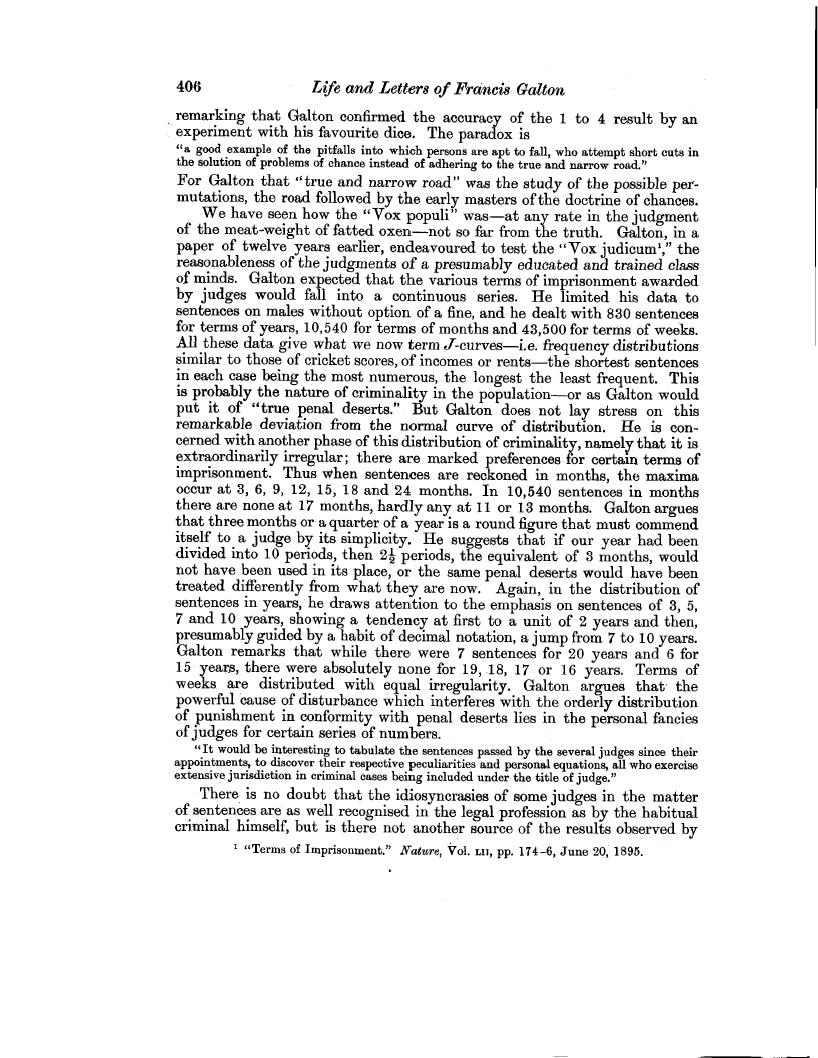406 Life and Letters of Francis Galton
remarking that Galton confirmed the accuracy of the 1 to 4 result by an experiment with his favourite dice. The paradox is
"a good example of the pitfalls into which persons are apt to fall, who attempt short cuts in the solution of problems of chance instead of adhering to the true and narrow road."
For Galton that "true and narrow road" was the study of the possible permutations, the road followed by the early masters of the doctrine of chances.
We have seen how the "Vox populi" was-at any rate in the judgment of the meat-weight of fatted oxen-not so far from the truth. Galton, in a paper of twelve years earlier, endeavoured to test the "Vox judicum'," the reasonableness of the judgments of a presumably educated and trained class of minds. Galton expected that the various terms of imprisonment awarded by judges would fall into a continuous series. He limited his data to sentences on males without option of a fine, and he dealt with 830 sentences for terms of years, 10,540 for terms of months and 43,500 for terms of weeks. All these data give what we now term J-curves-i.e. frequency distributions similar to those of cricket scores, of incomes or rents-the shortest sentences in each case being the most numerous, the longest the least frequent. This is probably the nature of criminality in the population-or as Galton would put it of "true penal deserts." But Galton does not lay stress on this remarkable deviation from the normal curve of distribution. He is concerned with another phase of this distribution of criminality, namely that it is extraordinarily irregular; there are marked preferences for certain terms of imprisonment. Thus when sentences are reckoned in months, the maxima occur at 3, 6, 9, 12, 15, 18 and 24 months. In 10,540 sentences in months there are none at 17 months, hardly any at 11 or 13 months. Galton argues that three months or a quarter of a year is a round figure that must commend itself to a judge by its simplicity. He suggests that if our year had been divided into 10 periods, then 22 periods, the equivalent of 3 months, would not have been used in its place, or the same penal deserts would have been treated differently from what they are now. Again, in the distribution of sentences in years, he draws attention to the emphasis on sentences of 3, 5, 7 and 10 years, showing a tendency at first to a unit of 2 years and then, presumably guided by a habit of decimal notation, a jump from 7 to 10 years. Galton remarks that while there were 7 sentences for 20 years and 6 for 15 years, there were absolutely none for 19, -18, 17 or 16 years. Terms of weeks are distributed with equal irregularity. Galton argues that the powerful cause of disturbance which interferes with the orderly distribution of punishment in conformity with penal deserts lies in the personal fancies of judges for certain series of numbers.
"It would be interesting to tabulate the sentences passed by the several judges since their appointments, to discover their respective peculiarities and personal equations, all who exercise extensive jurisdiction in criminal cases being included under the title of judge."
There is no doubt that the idiosyncrasies of some judges in the matter of sentences are as well recognised in the legal profession as by the habitual criminal himself, but is there not another source of the results observed by
1 "Terms of Imprisonment." Nature, Vol. LIT, pp. 174-6, June 20, 1895.

